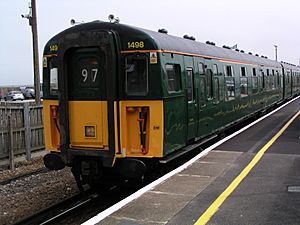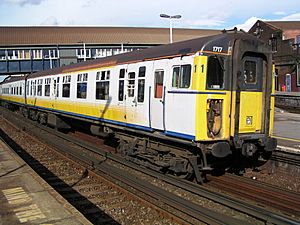British Rail Class 421 facts for kids
Quick facts for kids British Rail Class 421 |
|
|---|---|

Class 421/7 no. 1498 "Farringford" at Lymington Pier on 26 May 2005. This unit has been restored to 1960s-era British Railways green livery for use on the Lymington Branch Line.
|
|
| In service | 1964 - Current |
| Manufacturer | BREL York |
| Number built | Unknown |
| Formation | driving trailer + trailer + power car + driving trailer |
| Operator(s) | British Rail, South West Trains |
| Specifications | |
| Car length | 265ft 8 1/2in |
| Width | ft 9 in (2.81m) |
| Height | 12ft 9 1/4in (3.89m) |
| Maximum speed | 90mph (145 km/h) |
| Weight | 150 Tons |
| Power output | 4 x 250 hp traction motors total 1,000 hp (746 kW) |
| Electric system(s) | 750V dc third rail |
| Track gauge | standard gauge |


The British Rail Class 421 was a type of electric train used in the UK. These trains were also known as "4Cig" units. They were built by British Rail at their York factory between 1964 and 1972.
These trains were designed to carry passengers. They were first used on the busy Brighton Main Line. Later, they also served routes to places like Portsmouth. The Class 421 trains replaced older models, such as the famous "Brighton Belle" units. People often called them "slam-door" trains because of how their doors closed.
Contents
What is a Class 421 Train?
The Class 421 is an electric multiple unit (EMU). This means it's a train made of several coaches that can run by itself. It doesn't need a separate engine to pull it. These trains get their power from electricity. They use a special "third rail" system. This rail carries 750 volts of direct current (DC) electricity.
How Were They Built?
These trains were built in two main groups. The first group was made from 1964 to 1966. The second group was built from 1969 to 1972. Each train usually had four coaches. This included two driving coaches, one regular coach, and one power coach. The power coach held the motors that made the train move.
Key Features of the 4Cig
The Class 421 trains were known for their distinctive "slam-doors." Passengers had to open and close these doors themselves. Each train weighed about 150 tons. They could reach a top speed of 90 miles per hour (145 km/h). The trains had four powerful motors. Together, these motors produced 1,000 horsepower.
Where Did They Operate?
The Class 421 trains were mainly used in the south of England. They ran on lines operated by British Rail. Later, they were used by South West Trains.
Early Routes
When they were first introduced, the 4Cig trains were a common sight. They served the busy route between London and Brighton. This line is known as the Brighton Main Line. They helped many commuters travel to and from work.
Later Services
Over time, these trains expanded their service. They also ran on lines connecting London to Portsmouth. Some units were even modified for specific routes. For example, some were used on the Lymington Branch Line. This line is a short route to the coast.
Life and Legacy of the Class 421
The Class 421 trains served for many years. They were a familiar part of the railway system. Many were eventually replaced by newer, more modern trains.
Withdrawal from Service
Most Class 421 trains were taken out of service by the early 2000s. Newer trains with automatic doors became more common. However, a few units were kept for special uses. Some were even preserved by railway enthusiasts.
Special Units
One special unit, number 1498, was painted in an old green color. This was to match the look of trains from the 1960s. It was used on the Lymington Branch Line for a while. This allowed people to experience a piece of railway history. The Class 421 trains played an important role in British railway history. They helped millions of people travel for decades.
Images for kids
-
Class 421/6 no. 1908 at London Victoria on 15 August 2004. This unit was one of eight modified 'Phase 1' unit fitted with Mk.6 motor bogies. It was also one of only four 'Phase 1' units to be repainted in South Central livery. It was withdrawn in October 2004 and has since been scrapped.
-
Class 421/4, no. 1879, at Charing Cross on 18 March 2003, with a service to Hastings. This unit was operated by South Eastern Trains, and is painted in Network SouthEast livery. This unit has since been withdrawn from traffic and scrapped.
-
Class 421/8, no. 1396, at Clapham Junction on 19 July 2003. This unit is one of eight "Greyhound" units converted from redundant 4Big units for use by South West Trains. The buffet coach was replaced with a spare 4Cep trailer vehicle, which is identifiable by its different windows as the second vehicle in the unit.








